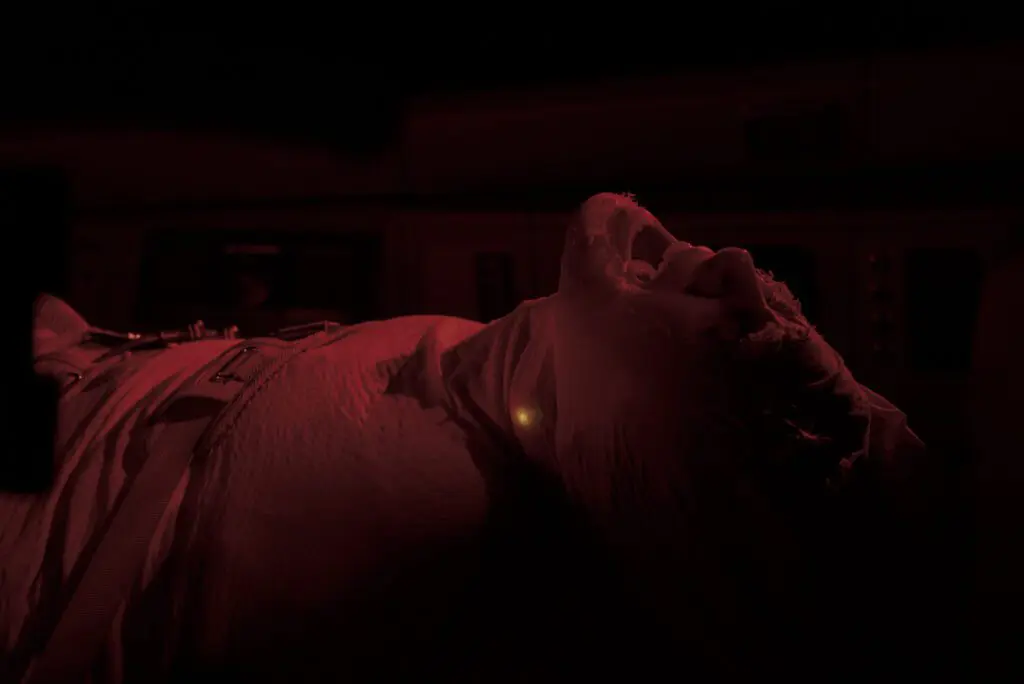Alexandre Aja’s Oxygen uses a single-location premise to tell the story of Elizabeth Hansen (Mélanie Laurent – as seen in Wingwomen), an amnesiac trapped in a cryogenic chamber, surviving on a diminishing supply of oxygen.
With little outside help, Hansen must attempt to escape the chamber or raise her oxygen levels in order to stay alive, an odd proposition without any memories to convince you that your life contains an immeasurable value.
A terrifying situation combined with a splendid, expressive performance from Laurent makes Netflix’s thriller worth a watch, especially with Aja at the helm.
Still, it becomes more difficult to understand the story of Elizabeth Hansen throughout the film, despite the leaking of various details as the plot progresses. Who is Elizabeth Hansen, and does she survive?
First and foremost, Elizabeth Hansen is a woman trapped in a cryogenic chamber. That’s the entirety of her identity through the first 30 minutes of Aja’s thriller. Over time, with the help of a mysterious woman and an AI assistant, she learns that she was a scientist focused on the mutation and cloning of rats. She was a mother and was married to a man named Léo.
From the snapshots of her memories, her research garnered her acclaim within the medical community, though it led to nightmares and ethical dilemmas. Each time she jabs her fingers into her wounds in the chamber, her old life floods back into her consciousness, giving her glimpses of who she was before being this prisoner.
Hansen learns that her husband got sick with a deadly virus, which seems to have ravaged the world. She watched her Léo die, and as she grew older, her work became dedicated to finding a way to bring him back.
All of this comes in bits and pieces, leaving the audience to fill in the blanks. Laurent does her best to express this journey through the anguish settled into the lines on her face, but Aja decides to leave much to the imagination.
Still, it takes time to understand why she’s in this cryogenic chamber, and the surprise comes in the third act, as Hansen realizes that she isn’t actually the original Elizabeth Hansen at all. She’s a clone of herself, floating toward a new planet, one that’s designed to be the home of the repopulated human race.
Due to a number of factors, many of which sound familiar in our current news cycles, from global warming to an increasing number of infectious, lethal diseases, the humans of Hansen’s world won’t survive another 100 years. Before she dies of old age, she sets off on a mission, along with a clone of her husband and hundreds of other clones, to reach a new home and a second chance at living.
A sci-fi shock that ends up making a great deal of sense, Oxygen’s final act ends with more than a tinge of hope, as Laurent reconnects her IVs in a painful, needle-driven sequence with mere minutes of oxygen left in her pod. She directs the oxygen from another person’s chamber, someone who unfortunately didn’t survive the lengthy space trip.
After cocooning herself and entering hypersleep, Aja gives us a glimpse of this new planet, a gorgeous destination to restart a species. Standing above a shoreline with her husband, Hansen looks as healthy as a clam, despite the trauma she suffered, which is not shown in these final moments.
Is Aja giving us hope as a human race? Is he just trying to give us a happy ending after a year of suffering and death? Regardless, the clone of Elizabeth Hansen survives, making her 90-minute brush with death, the rat-based hallucinations, and the IV stabbing worth it.




